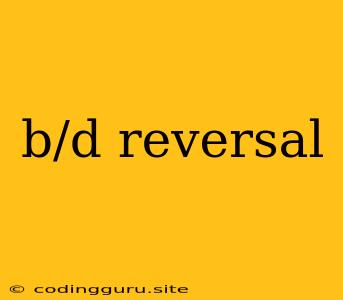Understanding and Addressing "b/d Reversal"
"b/d reversal" is a common issue faced by individuals with dyslexia or other learning disabilities. It refers to the tendency to confuse and interchange the letters 'b' and 'd'. While it may seem like a simple mistake, it can have a significant impact on reading, writing, and even daily life.
Why does "b/d reversal" happen?
The brain processes visual information and assigns meaning to letters. In the case of 'b' and 'd', these letters share a similar visual structure, with only a slight difference in the placement of the curve. This can create confusion for individuals struggling with dyslexia, leading to them inverting or reversing these letters.
Signs of "b/d reversal"
- Reading: Difficulty reading words containing 'b' and 'd', often misreading "bed" as "bed", "bad" as "dad", or "big" as "dig".
- Writing: Writing 'b' as 'd' or vice versa.
- Spelling: Inconsistent spelling, often mixing up words with 'b' and 'd'.
- General Confusion: Difficulty differentiating between left and right, and confusion with other similar-looking letters like 'p' and 'q'.
How to Address "b/d reversal"
1. Early Intervention is Key
Addressing "b/d reversal" early on can significantly improve a child's learning journey.
2. Sensory-Based Strategies
- Multi-Sensory Activities: Engage multiple senses by tracing letters in sand, air, or using tactile letters.
- Visual Cues: Use visual aids like color-coded letters or highlighting the difference in the placement of the curve.
- Auditory cues: Use flashcards with the letters pronounced aloud and practice saying the words out loud.
3. Explicit Instruction
- Direct Teaching: Focus on the specific differences between 'b' and 'd', emphasizing the position of the curve.
- Visual Memory Games: Play memory games with cards featuring 'b' and 'd' to improve visual recognition.
- Letter Formation Practice: Practice writing the letters correctly, focusing on the direction of the stroke.
4. Personalized Strategies
- Tailored Approach: Work with an educational specialist or therapist to develop personalized strategies based on individual needs.
- Technology: Utilize apps and computer programs that provide interactive learning experiences and visual feedback.
- Positive Reinforcement: Encourage and celebrate progress, fostering a positive learning environment.
Examples of "b/d reversal" in practice:
- Reading: A child reading "dad" instead of "bad" in a story.
- Writing: A student writing "b" when they meant to write "d" in a sentence.
- Spelling: A person spelling "bed" as "ded" in a word list.
Tips for Parents and Educators
- Be patient: Learning to distinguish between 'b' and 'd' can take time.
- Provide positive feedback: Encourage and praise effort, even small successes.
- Break down tasks: Focus on one letter at a time, gradually increasing the complexity.
- Create a fun learning environment: Make practice sessions engaging and interactive.
- Seek professional support: If you are concerned about "b/d reversal", consult with a specialist for personalized guidance.
Conclusion:
"b/d reversal" is a common challenge for individuals with dyslexia, but it can be addressed with effective strategies. Early intervention, multi-sensory learning, and personalized approaches can help overcome this difficulty and empower individuals to become confident readers and writers. Remember to be patient, supportive, and celebrate progress along the way.
